Fibrinogen Early In Severe paediatric Trauma studY (FEISTY junior): protocol for a randomised controlled trial
- PMID: 35508351
- PMCID: PMC9073392
- DOI: 10.1136/bmjopen-2021-057780
Fibrinogen Early In Severe paediatric Trauma studY (FEISTY junior): protocol for a randomised controlled trial
Abstract
Introduction: Trauma causes 40% of child deaths in high-income countries, with haemorrhage being a leading contributor to death in this population. There is a growing recognition that fibrinogen and platelets play a major role in trauma-induced coagulopathy (TIC) but the exact physiological mechanisms are poorly understood.
Methods and analysis: This is a prospective multicentre, open-label, randomised, two-arm parallel feasibility study conducted in the emergency departments, intensive care units and operating theatres of participating hospitals. Severely injured children, aged between 3 months and 18 years, presenting with traumatic haemorrhage requiring transfusion of blood products will be screened for inclusion.Sixty-eight patients will be recruited and will be allocated to fibrinogen replacement using fibrinogen concentrate (FC) or cryoprecipitate in a 1:1 ratio. Fibrinogen replacement will be administered to patients with a FIBTEM A5 of ≤10. All other aspects of the currently used rotational thromboelastometry-guided treatment algorithm and damage-control approach to trauma remain the same in both groups.The primary outcome is time to administration of fibrinogen replacement from time of identification of hypofibrinogenaemia. Clinical secondary outcomes and feasibility outcomes will also be analysed.
Ethics and dissemination: This study has received ethical clearance from the Children's Health Queensland Human Research Ethics Committee (HREC/17/QRCH/78). Equipment and consumables for sample testing have been provided to the study by Haemoview Diagnostics, Werfen Australia and Haemonetics Australia. FC has been provided by CSL Behring, Australia. The funding bodies and industry partners have had no input into the design of the study, and will not be involved in the preparation or submission of the manuscript for publication.The use of viscoelastic haemostatic assays and early fibrinogen replacement has the potential to improve outcomes in paediatric trauma through earlier recognition of TIC. This in turn may reduce transfusion volumes and downstream complications and reduce the reliance on donor blood products such as cryoprecipitate.The use of FC has implications for regional and remote centres who would not routinely have access to cryoprecipitate but could store FC easily. Access to early fibrinogen replacement in these centres could make a significant impact and assist in closing the gap in trauma care available to residents of these communities.Outcomes of this study will be submitted for publication in peer-reviewed journals and submitted for presentation at national and international scientific fora.
Trial registration number: NCT03508141.
Keywords: Bleeding disorders & coagulopathies; PAEDIATRICS; TRAUMA MANAGEMENT.
© Author(s) (or their employer(s)) 2022. Re-use permitted under CC BY-NC. No commercial re-use. See rights and permissions. Published by BMJ.
Conflict of interest statement
Competing interests: JW has received educational, travel and research support from TEM International and CSL Behring.
Figures
References
Publication types
MeSH terms
Substances
Associated data
LinkOut - more resources
Full Text Sources
Medical
Miscellaneous


